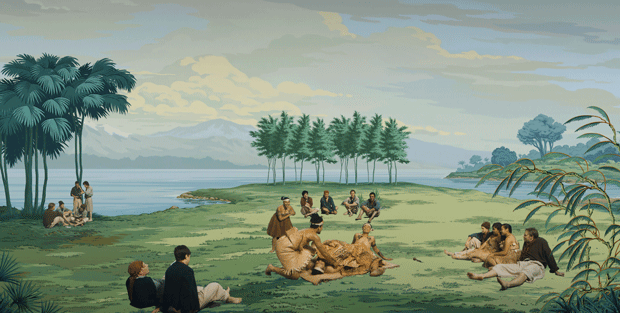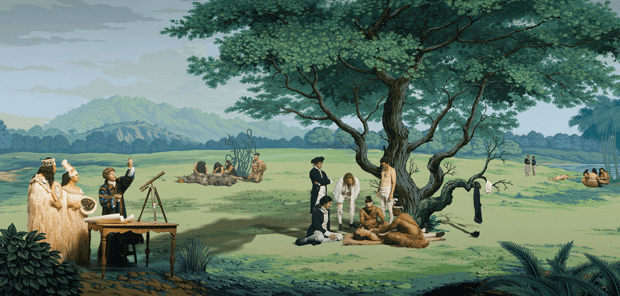Aug 3, 2015 Art
Right now, some of Auckland Art Gallery’s greatest treasures — Gottfried Lindauer’s Maori portraits — are on tour in Europe. The exhibition has already been to Berlin’s Old National Gallery, and is currently in Pilsen in the Czech Republic, Lindauer’s birthplace.
In New Zealand, Lindauer found a strong market for his academic portraiture, painting chiefs and other Maori dignitaries — and along with Goldie’s similar works his paintings have become an essential part of our art history.
But just as we were sending them on the road, the Ministry for Culture and Heritage announced that another important group of taonga were finally on their way back. Te Papa had negotiated the largest-ever repatriation of Maori remains, from New York’s American Museum of Natural History, and among the various body parts were a group of Toi Moko — tattooed and preserved Maori heads — sold to the museum in 1907 by Horatio Gordon Robley.
Robley was the ultimate collector-soldier. He is also the subject of one of the weirdest photographs of our late-colonial era. In it, Robley sits contemplatively with a patu in his lap. Behind him, his head collection is mounted on the wall; a decapitated grid offered up for quiet, pseudo-scientific contemplation. It is one of the most important visual documents we have of the strange, beautiful violence of cultural collision. Now, the heads are home.

This movement of our colonial objects and images provides an important context to consider Lisa Reihana’s most ambitious work to date. Currently on display at Auckland Art Gallery, In Pursuit of Venus (infected) (iPOVi) is a vast, 30-minute, tech-heavy film that tackles the history of Pacific representation and the traumatic sensuality embedded in early colonial contact.
Reihana’s starting point is an 1804 French wallpaper titled Les Sauvages de la Mer Pacifique, which took scenes from the voyages of Cook, de Bougainville and de la Pérouse and turned them into an entertaining bit of décor; Pacific vignettes that play out against an idealised view of Tahiti.
Using cutting-edge editing technology, Reihana has brought the paper to life. The backdrop is the same idyllic Polynesian setting, but embedded within it are live-action scenes; those charming little moments from the wallpaper made considerably more complicated as actors and dancers perform events from the period. Cook and Joseph Banks are there, as well as Cook’s Polynesian navigator Tupaia. The Endeavour bobs on the horizon.
In a nod to the panoramic way the original wallpaper would have been installed, Reihana’s film scrolls past, starting with a few shipwrecked Europeans encountering regal Polynesians, through a gradual degradation of both sides as a result of booze, exchanges gone wrong, misinterpretations of words and deeds, and towards Pacific exploration’s most defining wound — Cook’s murder in Hawaii.
It’s huge, and mesmerising: a seductive crowd-pleaser. It’s the best and most important work Reihana has ever made.
Reihana is part of that golden generation of Maori artists who emerged in the 90s, and technology has always been a major factor in her work. Early coverage of iPOVi has fixated on the kit — the number of projectors, the pixels per inch, the size of the video file. But what matters far more is its engagement with the way technology changes how we access and understand cultural information. In an age when anyone in the world can Google “Robley heads” or “Lindauer portraits”, or download a pattern for a tribal sleeve tattoo, the idea that an image gains its cultural meaning only in the place it came from, and via the people it belongs to, is up for grabs.

iPOVi isn’t actually about how Pacific exploration has been represented. It’s about the way technology can transform how we look at those representations, and how we invest in the space they create between erotic fantasy and historical reality.
Amid some pretty patchy acting, it’s the Polynesian performers and dancers who become the defining forces in Reihana’s film. They embody an uncomfortable truth: Europeans have always liked looking at brown bodies.
More than 140,000 people visited the Lindauer show in Berlin; catch a long-haul flight home from Europe and you’ll be among travellers earnest about wanting to see natives dancing in grass skirts.
The British media praised Kate Middleton’s “eyes-forward” discipline as, primly buttoned-up, she encountered a Maori warrior’s bare bum. We became ultra-serious in reply, explaining the cultural protocols and traditions involved. None of that was going to change what the rest of the world saw: a skinny white princess confronted with the erotic prospect of a near-naked Maori man.
The warrior-turned-sex-object is as old as The Odyssey. Ever since Cook landed in Tahiti, the Pacific has been the place where that archetype thrived. Cook came down here to watch Venus cross the sun’s face but he and his crew encountered a different Venus: they found heat, and sex, and confusion. European culture was infected by what Cook’s men saw and felt, and it’s never quite recovered.
It’s precisely this troubled desire that drives the cross-cultural exchanges and rising drama in iPOVi. Reihana has turned the idea of early “contact” from a historical abstraction into something sticky, complicated and real. Her willingness to focus on Polynesian bodies has always been her greatest strength — not as a reaction against their colonial victimhood but as an acknowledgment of the immense mana tied up with their ritual importance and self-representation. Sex is essential to that.
iPOVi’s biggest conundrum is also its major achievement: it tricks us into wanting it so badly. It pulls us in, uses us for 30 minutes, then throws us out again, stunned by the encounter. And it’s part of a great European tradition. Paul Gauguin’s paintings of Tahitian girls are upsetting in all sorts of ways. But they’re also bloody amazing pictures of power and sexual agency, which changed the course of Western art.





